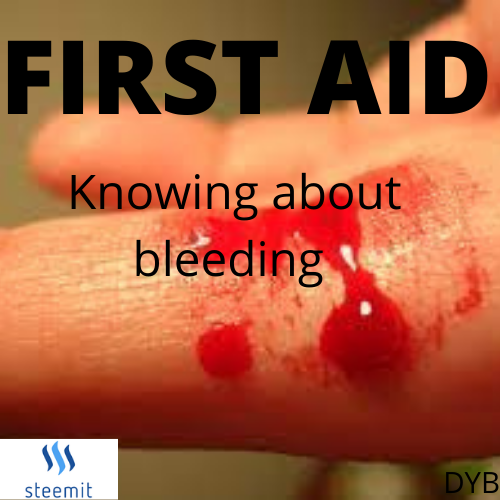
Source
The purpose of this lesson is to help us understand the various kinds of bleeding and how to control them.
Blood is the transport agent which carries oxygen and nutrients through the circulatory system to the various parts of the body.
TYPES OF BLEEDING
INTERNAL BLEEDING
When blood leaks out of the vessel and remains within the body, sometimes they are seen through the natural opening of the body, i.e. the mouth, nose, ears, etc. Internal bleeding may occur as a result of damage to the tissues or organs in the body. It normally appears as swellings on the skin, since the skin is intact or undamaged. Internal bleeding may remain in the chest region, the skull, the eye, and the tissues.

Source
EXTERNAL BLEEDING
This occurs when the blood escapes from the vessel and passes through the skin. In this regard, the blood is seen on the skin which makes controlling much easier as compared to the internal bleeding.

Source
HEMOLYSIS
Normally there is the destruction of red blood cells due to severe infections. It is normally caused by a disease. It may either be internal or external.
CAUSES OF BLEEDING
Most bleedings are caused by trauma or injuries to the body; however, others are caused by an increased risk of bleeding due to an underlying medical condition
Traumatic
Cut on the skin
Heavy blow to the body

Source
Blunt object hurt the tissues under the skin
Scrape or friction on the skin
Medical
Weakness in the blood vessel
Ulcer formation
Cancer and infections
Increased Blood pressure (Bp)
NB; Normally, with the medical causes, there is little you can do except you are a qualified health professional.
SIGNS AND SYMPTOMS OF BLEEDING
Pain
Swelling
Anxiety
Thirst
Weakness
Blood is seen on the site
Vomiting or coughing up blood
Bleeding from the body's opening such as the ears, nose, rectum, or vagina.
Shortness of breath
MANAGEMENT OF BLEEDING
Trauma bleeding (minor injuries)
In the management of this type of bleeding, you may use the acronym PRICE.
P Protect - Protect yourself, the victim, and others from possible infection.
R Rest - Rest the affected part and be calm since any fast movement may increase the bleeding.
I Ice - Apply Ice pack on the swollen part to shrink damaged tissue or blood vessels to control bleeding. Cold reduces swelling, pain, and bleeding.
C Compression - Compress the affected part by bandaging or use any clean cloth available on the affected part firmly but not tightly.

Source
E Elevate - Elevate the affected part above the heart to reduce the flow of blood.
Medical Bleeding
It is advisable for every person to alert his or her doctor when there is blood from the body cavities or blood in a cough. A regular medical check-up will also go a long way to salvage serious medical conditions.
NOTE
If there is no external bleeding but the victim is pale, think of internal bleeding and rush the victim to the nearest health center.
Thank you for following through with today's session. I hope you have learned a lot.
The next lesson will be on INJURIES TO THE BODY ( Bleeding lesson 2)
THANK YOU.
Downvoting a post can decrease pending rewards and make it less visible. Common reasons:
Submit
Downvoting a post can decrease pending rewards and make it less visible. Common reasons:
Submit